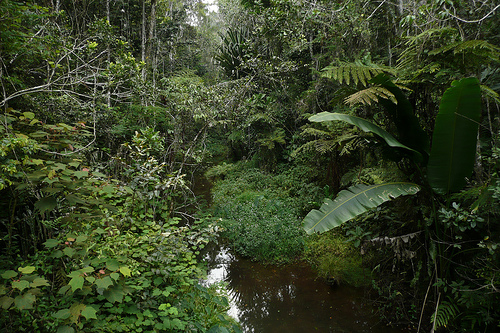

Location: Map
Area: 155 sq km
The Perinet Rainforest, also known as the Analamazaotra Special Reserve (ASR) or Périnet Special Reserve, is a key component of the larger Andasibe-Mantadia National Park in eastern Madagascar. Located approximately 150 km east of the capital city, Antananarivo, in the Alaotra-Mangoro Region, the park spans 155 square kilometers of primary rainforest at elevations between 800 and 1,260 meters. It features a humid climate with an average annual rainfall of 1,700 mm spread over 210 days. The area is accessible via a 3-hour drive on the paved Route Nationale 2 (RN 2), with the nearest towns being Moramanga and Andasibe (formerly Perinet). The Perinet section is particularly visitor-friendly, situated a short walk from the main road, while the Mantadia part requires special transport. The park's coordinates are around 18°49′36″S 48°26′52″E, making it one of Madagascar's most accessible protected areas for ecotourism.
Established in 1989, Andasibe-Mantadia National Park is managed by the Madagascar National Parks Association (PNM-ANGAP). The Perinet Rainforest refers specifically to the Analamazaotra Reserve, which was historically part of a larger forested area including the Mantadia National Park, Maromizaha Classified Forest, and Anosibe an’ala. However, extensive logging and deforestation for agriculture have isolated these sections over time. In 2007, the park was nominated for inclusion in the UNESCO World Heritage Site "Rainforests of the Atsinanana," but it was not selected. Visitor numbers have grown, reaching 26,054 in 2011, reflecting its increasing popularity. The name "Perinet" originates from the colonial era, tied to the nearby railway station, and the area has long been recognized for its biodiversity, drawing scientific interest since the early 20th century.
Andasibe-Mantadia, including the Perinet Rainforest, is a
biodiversity hotspot characterized by dense primary montane rainforest.
Madagascar's isolation for over 160 million years has led to exceptional
endemism, with over 80% of species unique to the island. The park hosts
a rich array of flora, including orchids, ferns, and endemic trees,
though much of the surrounding habitat has been replaced by non-native
eucalyptus and pine plantations.
Fauna is particularly diverse, with
11 lemur species as highlights. The Perinet section is renowned for its
population of the indri (Indri indri), Madagascar's largest lemur, known
for its haunting, whale-like calls that echo through the forest. Other
lemurs include the diademed sifaka, black-and-white ruffed lemur, common
brown lemur, grey bamboo lemur, eastern bamboo lemur, woolly lemur, and
red-bellied lemur. The park is also a haven for over 100 frog species,
earning it the title of the "world’s capital of frogs," along with
vibrant butterflies, birds (such as the Madagascar blue pigeon and
ground rollers), and reptiles like the Parson’s chameleon—the largest
chameleon species. Nocturnal species include the insectivorous tenrec,
resembling a hedgehog. Overall, the park supports many rare and
endangered endemic species, contributing to Madagascar's status as a
megadiverse country with ecosystems ranging from rainforests to
mangroves.
Madagascar has lost over 40% of its forest cover in the last 60
years, with less than 15% remaining natural forest. In
Andasibe-Mantadia, primary threats include habitat loss from logging,
slash-and-burn agriculture (tavy), and population growth, exacerbating
poverty and resource extraction. Conservation initiatives focus on
balancing resource use with protection. Nearby reserves promote
sustainable alternatives to deforestation.
A key project is the
Analamazaotra Re-introduction/Translocation (ART) program, launched in
2006 by the Madagascar Biodiversity Partnership, Omaha's Henry Doorly
Zoo & Aquarium, and local authorities. Following IUCN guidelines, it
relocates endangered lemurs like diademed sifaka and black-and-white
ruffed lemurs from threatened areas to the safer Perinet Reserve. By
2014, 26 sifakas and 8 ruffed lemurs were successfully translocated,
with monitoring via radio collars and health assessments. The project
has seen multiple generations of offspring and includes community
education and employment for local guides. Broader efforts by
organizations like WWF and Rainforest Trust address biodiversity threats
across Madagascar, emphasizing the island's unique wildlife, where over
90% is endemic.
The park offers guided hikes lasting 1 to 6 hours in both the Perinet and Mantadia sections, with a local guide mandatory for entry. Activities emphasize wildlife viewing, particularly lemur spotting in the Perinet area, where indris are commonly observed. Night hikes reveal nocturnal creatures like tenrecs and frogs. Visitors can also explore nearby Lemur Island, a sanctuary for orphaned lemurs (brown, bamboo, and ruffed varieties) that are habituated to humans, allowing close interactions and photography. Easy forest walks introduce the eastern rainforest's flora and fauna, with multiple days ideal for comprehensive exploration. The park's accessibility makes it a staple on itineraries like those from Wilderness Travel, focusing on Madagascar's off-the-beaten-path experiences.